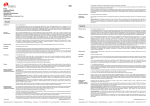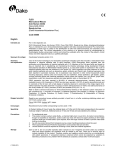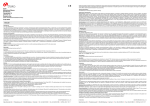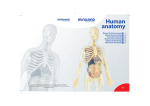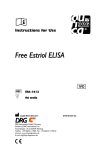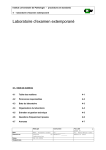Download FLEX Monoclonal Mouse Anti-Human Placental Alkaline
Transcript
All incubation steps should be performed at room temperature. For details, please refer to the Operator’s Manual for the dedicated instrument. If the protocols are not available on the used Dako Autostainer instrument, please contact Dako Technical Services. Optimal conditions may vary depending on specimen and preparation methods, and should be determined by each individual laboratory. If the evaluating pathologist should desire a different staining intensity, a Dako Application Specialist/Technical Service Specialist can be contacted for information on re-programming of the protocol. Verify that the performance of the adjusted protocol is still valid by evaluating that the staining pattern is identical to the staining pattern described in “Performance characteristics”. FLEX Monoclonal Mouse Anti-Human Placental Alkaline Phosphatase Clone 8A9 Ready-to-Use (Dako Autostainer/Autostainer Plus) Code IS779 Counterstaining in hematoxylin is recommended using EnVision FLEX Hematoxylin, (Dako Autostainer/Autostainer Plus) (Code K8018). Non-aqueous, permanent mounting medium is recommended. Positive and negative controls should be run simultaneously using the same protocol as the patient specimens. The positive control tissue should include placenta and the cells/structures should display reaction patterns as described for this tissue in “Performance characteristics” in all positive specimens. The recommended negative control reagent is FLEX Negative Control, Mouse, (Dako Autostainer/Autostainer Plus) (Code IS750). Staining interpretation Cells labeled by the antibody display cytoplasmic staining. Performance characteristics Normal tissues: The antibody labels syncytiotrophoblast cells in third trimester placentae and germ cells in testis. In placenta, the brushborder of the syncytiotrophoblast and trophoblast shows a moderate to strong staining reaction, whereas the cytoplasmic compartment of the syncytiotrophoblast and trophoblast shows a weak to moderate staining reaction. Please note that staining in striated and smooth muscle cells with this antibody has been observed. Abnormal tissues: The antibody labeled 19/22 seminomas, 2/14 yolk sac tumors, and 7/24 embryonal carcinomas (2), as well as 17/21 desmoplastic small round cell tumors (3). ENGLISH Intended use For in vitro diagnostic use. FLEX Monoclonal Mouse Anti-Human Placental Alkaline Phosphatase, Clone 8A9, Ready-to-Use, (Dako Autostainer/Autostainer Plus), is intended for use in immunohistochemistry together with Dako Autostainer/ Autostainer Plus instruments. This antibody labels cells expressing placental alkaline phosphatase (PLAP) and PLAP-like alkaline phosphatase, also named germ cell AP (GCAP) (1). This antibody is useful for the identification of seminomas (2) and desmoplastic small round cell tumors (3). Antibodies to PLAP/GCAP are particularly useful for the identification of germ cell tumors (4-6). The clinical interpretation of any staining or its absence should be complemented by morphological studies using proper controls and should be evaluated within the context of the patient's clinical history and other diagnostic tests by a qualified pathologist. Summary and explanation In humans, alkaline phosphatases (APs, EC. 3.1.3.1) are encoded by a gene family composed of four loci; three tissue-specific AP (TSAP) genes (i.e. placental AP (PLAP), germ cell AP (GCAP), and intestinal AP (IAP)) are clustered at the end of the long arm of chromosome 2, bands q34-q37, while a single, tissue non-specific AP (TNAP) gene is located at the short arm of chromosome 1, bands p36.1-p34. The three TSAP isoenzymes are highly homologous displaying 90-98% identity in their amino acid sequence, while TNAP is only 50-60% homologous to the TSAPs (1). In normal tissues, PLAP is expressed in the syncytiotrophoblasts of the placenta from about the 8th week of gestation, and the concentration increases continually throughout pregnancy (1). Additionally, PLAP is expressed in endocervix and in Fallopian tube (6). GCAP is expressed in primordial germ cells during their migration through the genital ridges, as well as in trace amounts during the first steps of germ cell maturation in normal adult testis, and in the thymus. IAP is normally expressed in fetal and adult intestinal mucosa, more specifically the microvillous border of the epithelial cells. TNAP is expressed in a multitude of tissues, including liver, bone, kidney, lung and in the placenta until about the 12th week of pregnancy (1). In neoplastic tissues, PLAP has been observed in cancer of the lung, ovary, uterus and proximal gastro-intestinal tissues, while it is rarely found in germ cell tumors (1, 6). GCAP, in contrast, is present in the majority of germ cell tumors, notably in carcinoma in situ of the testis (CIS) and in seminoma (1, 5, 6). IAP has been detected in hepatocellular carcinoma and renal cell carcinoma. Commonly, tumors express more than one AP isoenzyme (1). Refer to Dako’s General Instructions for Immunohistochemical Staining or the detection system instructions of IHC procedures for: 1) Principle of Procedure, 2) Materials Required, Not Supplied, 3) Storage, 4) Specimen Preparation, 5) Staining Procedure, 6) Quality Control, 7) Troubleshooting, 8) Interpretation of Staining, 9) General Limitations. Reagent provided FRANÇAIS Utilisation prévue Pour utilisation diagnostique in vitro. FLEX Monoclonal Mouse Anti-Human Placental Alkaline Phosphatase, Clone 8A9, Ready-to-Use, (Dako Autostainer/Autostainer Plus) est destiné à une utilisation en immunohistochimie avec les instruments Dako Autostainer/Autostainer Plus. Cet anticorps marque des cellules exprimant la phosphatase alcaline placentaire (PLAP) et la phosphatase alcaline similaire à la PLAP, également appelée phosphatase alcaline des cellules germinales (GCAP) (1). Cet anticorps facilite l’identification des séminomes (2) et des tumeurs desmoplastiques à petites cellules rondes (3). Les anticorps anti-PLAP/GCAP sont particulièrement utiles pour l’identification des tumeurs à cellules germinales (4-6). L’interprétation clinique de toute coloration ou son absence doit être complétée par des études morphologiques en utilisant des contrôles appropriés et doit être évaluée en fonction des antécédents cliniques du patient et d’autres tests diagnostiques par un pathologiste qualifié. Résumé et explication Chez l’homme, les phosphatases alcalines (PA, EC. 3.1.3.1) sont codées par une famille de gènes composée de quatre loci ; trois gènes PA spécifiques au tissu (TSAP) (à savoir la PA placentaire (PLAP), la PA des cellules germinales (GCAP) et la PA intestinale (PAI)) sont groupés à l’extrémité du bras long du chromosome 2, des bandes de q34-q37, alors qu’un seul gène PA non spécifique au tissu (TNAP) est situé sur le bras court du chromosome 1, bandes p36.1-p34. Les trois isoenzymes TSAP sont hautement homologues, étant similaires à 90–98 % de par leur séquence d’acides aminés, alors que la TNAP n’est homologue aux TSAP qu’à 50–60 % (1). Dans les tissus sains, la PLAP est exprimée dans les syncytiotrophoblastes du placenta à partir de la 8e semaine de grossesse environ, et sa concentration augmente continuellement au cours de la grossesse (1). De plus, la PLAP est exprimée au niveau de l’endocol et des trompes de Fallope (6). La GCAP est exprimée dans les cellules germinales primordiales pendant leur migration à travers les crêtes génitales, ainsi que sous forme de traces pendant les premières étapes de la maturation des cellules germinales dans les testicules adultes sains, et dans le thymus. La PAI est normalement exprimée dans la muqueuse intestinale du fœtus et de l'adulte, plus particulièrement à la bordure de microvillosité des cellules épithéliales. La TNAP est exprimée dans une multitude de tissus, y compris le foie, l’os, le rein, le poumon et le placenta jusqu’à environ la 12e semaine de grossesse (1). Dans les tissus néoplasiques, la PLAP a été observée dans le cancer du poumon, de l’ovaire, de l’utérus et des tissus gastro-intestinaux proximaux, alors qu’elle est rarement présente dans les tumeurs à cellules germinales (1, 6). La GCAP, en revanche, est présente dans la majorité des tumeurs à cellules germinales, notamment dans le carcinome in situ du testicule (CIS) et dans le séminome (1, 5, 6). La PAI a été détectée dans le carcinome hépatocellulaire et dans le carcinome à cellules rénales. Généralement, les tumeurs expriment plus qu’un isoenzyme de la PA (1). Se référer aux Instructions générales de coloration immunohistochimique de Dako ou aux instructions du système de détection relatives aux procédures IHC pour plus d’informations concernant les points suivants : 1) Principe de procédure, 2) Matériels requis mais non fournis, 3) Conservation, 4) Préparation des échantillons, 5) Procédure de coloration, 6) Contrôle qualité, 7) Dépannage, 8) Interprétation de la coloration, 9) Limites générales. Réactifs fournis Anticorps monoclonal de souris prêt à l’emploi fourni sous forme liquide dans un tampon contenant une protéine stabilisante et 0,015 mol/L d’azide de sodium. Clone : 8A9. Isotype : IgG1, kappa. Immunogène Phosphatase alcaline placentaire humaine purifiée. Spécificité Comme démontré par immunohistochimie, l’anticorps marque les séminomes et le placenta, reconnaissant probablement la PLAP et la GCAP. Précautions 1. Pour utilisateurs professionnels. 2. Ce produit contient de l’azide de sodium (NaN3), produit chimique hautement toxique dans sa forme pure. Aux concentrations du produit, bien que non classé comme dangereux, l’azide de sodium peut réagir avec le cuivre et le plomb des canalisations et former des accumulations d’azides métalliques hautement explosifs. Lors de l’élimination, rincer abondamment à l’eau pour éviter toute accumulation d’azide métallique dans les canalisations. 3. Comme avec tout produit d’origine biologique, des procédures de manipulation appropriées doivent être respectées. 4. Porter un vêtement de protection approprié pour éviter le contact avec les yeux et la peau. 5. Les solutions non utilisées doivent être éliminées conformément aux réglementations locales et nationales. Conservation Conserver entre 2 et 8 °C. Ne pas utiliser après la date de péremption indiquée sur le flacon. Si les réactifs sont conservés dans des conditions autres que celles indiquées, celles-ci doivent être validées par l’utilisateur. Il n’y a aucun signe évident indiquant l’instabilité de ce produit. Par conséquent, des contrôles positifs et négatifs doivent être testés en même temps que les échantillons de patient. Si une coloration inattendue est observée, qui ne peut être expliquée par un changement des procédures du laboratoire, et en cas de suspicion d’un problème lié à l’anticorps, contacter l’assistance technique de Dako. Préparation des échantillons y compris le matériel requis mais non fourni L’anticorps peut être utilisé pour le marquage des coupes de tissus inclus en paraffine et fixés au formol. L’épaisseur des coupes d’échantillons de tissu doit être d’environ 4 µm. Un prétraitement avec démasquage d’épitope induit par la chaleur (HIER) est nécessaire avec le Dako PT Link (Réf. PT100/PT101). Pour plus de détails, se référer au Guide d’utilisation du PT Link. Des résultats optimaux sont obtenus en prétraitant les tissus à l’aide de la EnVision FLEX Target Retrieval Solution, High pH (50x) (Réf. K8010/K8004). Coupes incluses en paraffine : le prétraitement des coupes tissulaires fixées au formol et incluses en paraffine est recommandé à l'aide de la procédure de préparation d'échantillon 3-en-un pour le Dako PT Link. Suivre la procédure de prétraitement indiquée dans la notice de la EnVision FLEX Target Retrieval Solution, High pH (50x) (Réf. K8010/K8004). Remarque : après coloration, les coupes doivent être déshydratées, lavées et montées à l’aide d’un milieu de montage permanent. Ready-to-use monoclonal mouse antibody provided in liquid form in a buffer containing stabilizing protein and 0.015 mol/L sodium azide. Clone: 8A9. Isotype: IgG1, kappa. Immunogen Purified human placental alkaline phosphatase. Specificity As demonstrated by immunohistochemistry, the antibody labels seminomas and placenta, recognising possibly both PLAP and GCAP. Precautions 1. For professional users. 2. This product contains sodium azide (NaN3), a chemical highly toxic in pure form. At product concentrations, though not classified as hazardous, sodium azide may react with lead and copper plumbing to form highly explosive build-ups of metal azides. Upon disposal, flush with large volumes of water to prevent metal azide build-up in plumbing. 3. As with any product derived from biological sources, proper handling procedures should be used. 4. Wear appropriate Personal Protective Equipment to avoid contact with eyes and skin. 5. Unused solution should be disposed of according to local, State and Federal regulations. Storage Store at 2-8 °C. Do not use after expiration date sta mped on vial. If reagents are stored under any conditions other than those specified, the conditions must be verified by the user. There are no obvious signs to indicate instability of this product. Therefore, positive and negative controls should be run simultaneously with patient specimens. If unexpected staining is observed which cannot be explained by variations in laboratory procedures and a problem with the antibody is suspected, contact Dako Technical Support. Specimen preparation including materials required but not supplied Staining procedure including materials required but not supplied (115292-002) Dako Denmark A/S The antibody can be used for labeling formalin-fixed, paraffin-embedded tissue sections. Tissue specimens should be cut into sections of approximately 4 µm. Pre-treatment with heat-induced epitope retrieval (HIER) is required using Dako PT Link (Code PT100/PT101). For details, please refer to the PT Link User Guide. Optimal results are obtained by pretreating tissues using EnVision FLEX Target Retrieval Solution, High pH (50x) (Code K8010/K8004). Paraffin-embedded sections: Pre-treatment of formalin-fixed, paraffin-embedded tissue sections is recommended using the 3-in-1 specimen preparation procedure for Dako PT Link. Follow the pre-treatment procedure outlined in the package insert for EnVision FLEX Target Retrieval Solution, High pH (50x) (Code K8010/K8004). Note: After staining the sections must be dehydrated, cleared and mounted using permanent mounting medium. Deparaffinized sections: Pre-treatment of deparaffinized formalin-fixed, paraffin-embedded tissue sections is recommended using Dako PT Link and following the same procedure as described for paraffin-embedded sections. After staining the slides should be mounted using aqueous or permanent mounting medium. The tissue sections should not dry out during the treatment or during the following immunohistochemical staining procedure. For greater adherence of tissue sections to glass slides, the use of FLEX IHC Microscope Slides (Code K8020) is recommended. The recommended visualization system is EnVision FLEX, High pH, (Dako Autostainer/Autostainer Plus) (Code K8010). The staining steps and incubation times are pre-programmed into the software of Dako Autostainer/Autostainer Plus instruments, using the following protocols: Template protocol: FLEXRTU2 (200 µL dispense volume) or FLEXRTU3 (300 µL dispense volume) Autoprogram: PLAP (without counterstaining) or PLAPH (with counterstaining) The Auxiliary step should be set to “rinse buffer” in staining runs with ≤10 slides. For staining runs with >10 slides the Auxiliary step should be set to “none”. This ascertains comparable wash times. IS779/EFG/MNI/2009.12.04 p. 1/4 | Produktionsvej 42 | DK-2600 Glostrup | Denmark | Tel. +45 44 85 95 00 | Fax +45 44 85 95 95 | CVR No. 33 21 13 17 (115292-002) Dako Denmark A/S IS779/EFG/MNI/2009.12.04 p. 2/4 | Produktionsvej 42 | DK-2600 Glostrup | Denmark | Tel. +45 44 85 95 00 | Fax +45 44 85 95 95 | CVR No. 33 21 13 17 Coupes déparaffinées : le prétraitement des coupes tissulaires déparaffinées, fixées au formol et incluses en paraffine, est recommandé à l’aide du Dako PT Link, en suivant la même procédure que pour les coupes incluses en paraffine. Après coloration, un montage aqueux ou permanent des lames est recommandé. Les coupes de tissus ne doivent pas sécher lors du traitement ni lors de la procédure de coloration immunohistochimique suivante. Pour une meilleure adhérence des coupes de tissus sur les lames de verre, il est recommandé d’utiliser des lames FLEX IHC Microscope Slides (Réf. K8020). Procédure de coloration y compris le matériel requis mais non fourni Le système de visualisation recommandé est le EnVision FLEX, High pH, (Dako Autostainer/Autostainer Plus) (Réf. K8010). Les étapes de coloration et d’incubation sont préprogrammées dans le logiciel des instruments Dako Autostainer/Autostainer Plus, à l’aide des protocoles suivants : Protocole modèle : FLEXRTU2 (volume de distribution de 200 µL) ou FLEXRTU3 (volume de distribution de 300 µL) Autoprogram : PLAP (sans contre-coloration) ou PLAPH (avec contre-coloration) L’étape Auxiliary doit être réglée sur « rinse buffer » lors des cycles de coloration avec ≤10 lames. Pour les cycles de coloration de >10 lames, l’étape Auxiliary doit être réglée sur « none ». Cela garantit des temps de lavage comparables. Toutes les étapes d’incubation doivent être effectuées à température ambiante. Pour plus de détails, se référer au Manuel de l’opérateur spécifique à l'instrument. Si les protocoles ne sont pas disponibles sur l’instrument Dako Autostainer utilisé, contacter le service technique de Dako. Les conditions optimales peuvent varier en fonction du prélèvement et des méthodes de préparation, et doivent être déterminées par chaque laboratoire individuellement. Si le pathologiste qui réalise l’évaluation désire une intensité de coloration différente, un spécialiste d’application/spécialiste du service technique de Dako peut être contacté pour obtenir des informations sur la re-programmation du protocole. Vérifier que l'exécution du protocole modifié est toujours valide en vérifiant que le schéma de coloration est identique au schéma de coloration décrit dans les « Caractéristiques de performance ». Il est recommandé d’effectuer une contre-coloration à l’aide de EnVision FLEX Hematoxylin, (Dako Autostainer/Autostainer Plus) (Réf. K8018). L’utilisation d’un milieu de montage permanent non aqueux est recommandée. Des contrôles positifs et négatifs doivent être réalisés en même temps et avec le même protocole que les échantillons du patient. Le contrôle de tissu positif doit comprendre le placenta et les cellules/structures doivent présenter des schémas de réaction tels que décrits pour ces tissus dans les « Caractéristiques de performance » pour tous les échantillons positifs. Le contrôle négatif recommandé est le FLEX Negative Control, Mouse, (Dako Autostainer/Autostainer Plus) (Réf. IS750). Interprétation de la coloration Les cellules marquées par l’anticorps présentent une coloration cytoplasmique. Caractéristiques de performance Tissus sains : L’anticorps marque les cellules du syncytiotrophoblaste dans le placenta au troisième trimestre et dans les cellules germinales du testicule. Dans le placenta, la bordure en brosse du syncytiotrophoblaste et du trophoblaste présente une coloration modérée à forte, tandis que la coloration du compartiment cytoplasmique du syncytiotrophoblaste et du trophoblaste est faible à modérée. Il convient de noter qu’une coloration des cellules des muscles lisses et striés par cet anticorps a été observée. Tissus tumoraux : L’anticorps marque 19 cas de séminomes sur 22, 2 tumeurs du sac vitellin sur 14, 7 carcinomes embryonnaires sur 24 (2), ainsi que 17 tumeurs desmoplastiques à petites cellules rondes sur 21 (3). Vorsichtsmaßnahmen 1. Nur für Fachpersonal bestimmt. 2. Dieses Produkt enthält Natriumazid (NaN3), eine in reiner Form äußerst giftige Chemikalie. Natriumazid kann auch in als ungefährlich eingestuften Konzentrationen mit Blei- und Kupferrohren reagieren und hochexplosive Metallazide bilden. Nach der Entsorgung stets mit viel Wasser nachspülen, um Metallazidansammlungen in den Leitungen vorzubeugen. 3. Wie alle Produkte biologischen Ursprungs müssen auch diese entsprechend gehandhabt werden. 4. Geeignete Schutzkleidung tragen, um Augen- und Hautkontakt zu vermeiden. 5. Nicht verwendete Lösung ist entsprechend örtlichen, bundesstaatlichen und staatlichen Richtlinien zu entsorgen. Lagerung Bei 2–8 °C aufbewahren. Nach Ablauf des auf dem Fläschch en aufgedruckten Verfalldatums nicht mehr verwenden. Werden die Reagenzien unter anderen als den angegebenen Bedingungen aufbewahrt, müssen diese Bedingungen vom Benutzer validiert werden. Es gibt keine offensichtlichen Anzeichen für eine eventuelle Produktinstabilität. Positiv- und Negativkontrollen sollten daher zur gleichen Zeit wie die Patientenproben getestet werden. Falls es zu einer unerwarteten Färbung kommt, die sich nicht durch Unterschiede bei Laborverfahren erklären lässt und auf ein Problem mit dem Antikörper hindeutet, ist der technische Kundendienst von Dako zu verständigen. Vorbereitung der Probe und erforderliche, aber nicht mitgelieferte Materialien Der Antikörper eignet sich zur Markierung von formalinfixierten und paraffineingebetteten Gewebeschnitten. Gewebeproben sollten in Schnitte von ca. 4 µm Stärke geschnitten werden. Die Vorbehandlung durch hitzeinduzierte Epitopdemaskierung (HIER) mit Dako PT Link (Code-Nr. PT100/PT101) ist erforderlich. Weitere Informationen hierzu siehe PT Link-Benutzerhandbuch. Optimale Ergebnisse können durch Vorbehandlung der Gewebe mit EnVision FLEX Target Retrieval Solution, High pH (50x) (Code-Nr. K8010/K8004) erzielt werden. Paraffineingebettete Schnitte: Die Vorbehandlung der formalinfixierten, paraffineingebetteten Schnitte mit dem 3-in-1Probenvorbereitungsverfahren für Dako PT Link wird empfohlen. Vorbehandlung gemäß der Beschreibung in der Packungsbeilage für EnVision FLEX Target Retrieval Solution, High pH (50x) (Code-Nr. K8010/K8004) durchführen. Hinweis: Nach dem Färben müssen die Schnitte dehydriert, geklärt und mit permanentem Einbettmedium auf den Objektträger aufgebracht werden. Entparaffinierte Schnitte: Eine Vorbehandlung der entparaffinierten, formalinfixierten, paraffineingebetteten Gewebeschnitte mit Dako PT Link nach demselben Verfahren, wie für die paraffineingebetteten Schnitte beschrieben, wird empfohlen. Die Objektträger nach dem Färben mit einem wässrigen oder permanenten Einbettmedium bedecken. Die Gewebeschnitte dürfen während der Behandlung oder des anschließenden immunhistochemischen Färbeverfahrens nicht austrocknen. Zur besseren Haftung der Gewebeschnitte an den Glasobjektträgern wird die Verwendung von FLEX IHC Microscope Slides (Code-Nr. K8020) empfohlen. Färbeverfahren und erforderliche, aber nicht mitgelieferte Materialien Das empfohlene Visualisierungssystem ist EnVision™ FLEX, High pH (Dako Autostainer/Autostainer Plus) (Code-Nr. K8010). Die Färbeschritte und Inkubationszeiten sind in der Software der Dako Autostainer/Autostainer Plus-Geräte mit den folgenden Protokollen vorprogrammiert: Matrix-Protokoll: FLEXRTU2 (200 µL Abgabevolumen) oder FLEXRTU3 (300 µL Abgabevolumen) Autoprogram: PLAP (ohne Gegenfärbung) oder PLAPH (mit Gegenfärbung) Bei Färbedurchläufen mit höchstens 10 Objektträgern sollte der „Zusatz“-Schritt auf „Pufferspülgang“ eingestellt werden. Für Färbedurchläufe mit mehr als 10 Objektträgern den „Zusatz“-Schritt auf „Keine“ einstellen. Dieses gewährleistet vergleichbare Waschzeiten. Alle Inkubationsschritte sollten bei Raumtemperatur durchgeführt werden. Nähere Einzelheiten bitte dem Benutzerhandbuch für das jeweilige Gerät entnehmen. Wenn die Färbeprotokolle auf dem verwendeten Dako Autostainer-Gerät nicht verfügbar sind, bitte den Technischen Kundendienst von Dako verständigen. Optimale Bedingungen können je nach Probe und Präparationsverfahren unterschiedlich sein und sollten vom jeweiligen Labor selbst ermittelt werden. Falls der beurteilende Pathologe eine andere Färbungsintensität wünscht, kann ein Anwendungsspezialist oder Kundendiensttechniker von Dako bei der Neuprogrammierung des Protokolls helfen. Die Leistung des angepassten Protokolls muss verifiziert werden, indem gewährleistet wird, dass das Färbemuster mit dem unter „Leistungsmerkmale“ beschriebenen Färbemuster identisch ist. Die Gegenfärbung in Hämatoxylin sollte mit EnVision™ FLEX Hematoxylin, (Dako Autostainer/Autostainer Plus) (Code-Nr. K8018) ausgeführt werden. Empfohlen wird ein nichtwässriges, permanentes Fixiermittel. Positiv- und Negativkontrollen sollten zur gleichen Zeit und mit demselben Protokoll wie die Patientenproben getestet werden. Das positive Kontrollgewebe sollte Plazentagewebe enthalten und die Zellen/Strukturen müssen in allen positiven Proben die für dieses Gewebe unter „Leistungsmerkmale“ beschriebenen Reaktionsmuster aufweisen. Das empfohlene Negativ-Kontrollreagenz ist FLEX Negative Control, Mouse, (Dako Autostainer/Autostainer Plus) (Code-Nr. IS750). Auswertung der Färbung Mit diesem Antikörper markierte Zellen weisen ein zytoplasmatisches Färbemuster auf. Leistungsmerkmale Gesundes Gewebe: Der Antikörper markiert Synzytiotrophoblastenzellen in der Plazenta im dritten Trimenon und Keimzellen im Hoden. In der Plazenta zeigt der Bürstensaum der Synzytiotrophoblasten und der Trophoblasten eine mäßige bis starke Färbereaktion, während das zytoplasmatische Kompartiment der Synzytiotrophoblasten und Trophoblasten eine schwache bis mäßige Färbereaktion zeigt. Es ist zu beachten, dass in Zellen gestreifter und glatter Muskulatur ebenfalls eine Färbung mit diesem Antikörper beobachtet wurde. Pathologisches Gewebe: Der Antikörper markierte 19 von 22 Seminomen, 2 von 14 Dottersack-Tumoren und 7 von 24 embryonalen Karzinomen (2) sowie 17 von 21 desmoplastischen kleinrundzelligen Tumoren (3). DEUTSCH Zweckbestimmung Zur In-vitro-Diagnostik. FLEX Monoclonal Mouse Anti-Human Placental Alkaline Phosphatase, Clone 8A9, Ready-to-Use, (Dako Autostainer/Autostainer Plus) ist zur Verwendung in der Immunhistochemie in Verbindung mit Dako Autostainer/Autostainer Plus-Geräten bestimmt. Dieser Antikörper markiert Zellen, die plazentäre alkalische Phosphatase (PLAP) und PLAP-ähnliche alkalische Phosphatase (auch: keimzellspezifische alkalische Phosphatase, GCAP) exprimieren (1). Dieser Antikörper dient zur Erkennung von Seminomen (2) und desmoplastischen kleinrundzelligen Tumoren (3). Antikörper gegen PLAP/GCAP sind besonders nützlich zur Erkennung von Keimzelltumoren (4–6). Die klinische Auswertung einer eventuell eintretenden Färbung sollte durch morphologische Studien mit ordnungsgemäßen Kontrollen ergänzt werden und von einem qualifizierten Pathologen unter Berücksichtigung der Krankengeschichte und anderer Diagnostiktests des Patienten vorgenommen werden. Zusammenfassung und Erklärung Beim Menschen werden alkalische Phosphatasen (AP, EC.3.1.3.1) von einer Genfamilie kodiert, die 4 Loci einnimmt. Drei gewebespezifische AP-Gene (TSAP), wie PLAP, GCAP und intestinale alkalische Phosphatase (IAP) sind am Ende des langen Armes des Chromosoms 2 auf den Banden q34–q37 gruppiert. Ein einziges Gen für nicht gewebespezifische AP (TNAP) ist dagegen am kurzen Arm des Chromosoms 1, Banden p36.1–p34, lokalisiert. Die drei TSAP-Isoenzyme sind hochgradig homolog und zeigen 90–98 % Identität hinsichtlich ihrer Aminosäuren-Sequenzen, während TNAP nur 50–60 % Homologie im Vergleich zu den TSAP zeigt (1). In gesundem Gewebe wird PLAP auf Synzytiotrophoblasten der Plazenta exprimiert, und zwar ab etwa der 8. Schwangerschaftswoche, wobei die Konzentration während der gesamten Schwangerschaft kontinuierlich zunimmt (1). Außerdem erfolgt die PLAP-Expression in der Endozervix und in den Eileitern (6). GCAP wird auf primordialen Keimzellen während ihrer Migration durch die Genitalleisten exprimiert und spurenweise auch während der ersten Stadien der Keimzellenreifung in gesunden Hoden Erwachsener sowie im Thymus. IAP wird normalerweise in der fötalen und adulten Dünndarmschleimhaut exprimiert, genauer gesagt auf Epithelzellen am Microvilli-Saum. TNAP wird in einer Vielzahl von Geweben exprimiert, u. a. Leber, Knochen, Niere, Lunge und Plazenta bis zur etwa 12. Schwangerschaftswoche (1). In neoplastischen Geweben fand sich PLAP bei Lungen-, Eierstock- und Gebärmutterkrebs sowie in proximalem gastrointestinalem Gewebe, bei Keimzellentumoren wird PLAP dagegen nur selten nachgewiesen (1, 6). Im Gegensatz dazu liegt GCAP bei der Mehrzahl der Keimzellentumore vor, insbesondere bei testikulärem In-situ-Karzinom und bei Seminom (1, 5, 6). IAP konnte bei hepatozellulärem Karzinom und bei Nierenkarzinom nachgewiesen werden. Normalerweise exprimieren Tumore mehr als ein AP-Isoenzym (1). Folgende Angaben bitte den Allgemeinen Richtlinien zur immunhistochemischen Färbung von Dako oder den Anweisungen des Detektionssystems für IHC-Verfahren entnehmen: 1) Verfahrensprinzip, 2) Erforderliche, aber nicht mitgelieferte Materialien, 3) Aufbewahrung, 4) Vorbereitung der Probe, 5) Färbeverfahren, 6) Qualitätskontrolle, 7) Fehlersuche und -behebung, 8) Auswertung der Färbung, 9) Allgemeine Beschränkungen. Geliefertes Reagenz Gebrauchsfertiger, monoklonaler Maus-Antikörper in flüssiger Form in einem Puffer, der stabilisierendes Protein und 0,015 mol/L Natriumazid enthält. Klon: 8A9. Isotyp: IgG1, Kappa. Immunogen Gereinigte alkalische Phosphatase aus menschlicher Plazenta. Spezifität Immunhistochemische Untersuchungen haben ergeben, dass der Antikörper Seminome und Plazenta markiert, wahrscheinlich durch Erkennung von PLAP und GCAP. (115292-002) Dako Denmark A/S IS779/EFG/MNI/2009.12.04 p. 3/4 | Produktionsvej 42 | DK-2600 Glostrup | Denmark | Tel. +45 44 85 95 00 | Fax +45 44 85 95 95 | CVR No. 33 21 13 17 References/ Références/ Literatur 1. Millán JL, Fishman WH. Biology of human alkaline phosphatases with special reference to cancer. Crit Rev Clin Lab Sci 1995; 32:1-39. 2. Eyzaguirre E, Gatalica Z. Loss of fhit expression in testicular germ cell tumors and intratubular germ cell neoplasia. Mod Pathol 2002; 15:1068-72. 3. Zhang PJ, Golfblum JR, Pawel BR, Fischer C, Pasha TL, Barr FG. Immunophenotype of desmoplastic small round cell tumors as detected in cases with EWS-WT1 gene fusion product. Mod Pathol 2003; 16:229-35. 4. Leong AS-Y, Cooper K, Leong FJW-M. Manual of diagnostic antibodies for immunohistology. London: Oxford University Press; 1999. p. 277-8. 5. Dieckmann K-P, Skakkebaek NE. Carcinoma in situ of the testis: review of biological and clinical features. Int J Cancer 1999; 83:815-22. 6. Hamilton-Dutoit SJ, Lou H, Pallesen G. The expression of placental alkaline phosphatase (PLAP) and PLAP-like enzymes in normal and neoplastic human tissues. APMIS 1990; 98:797-811. Explanation of symbols/ Explication des symboles/ Erläuterung der Symbole Catalogue number Référence catalogue Bestellnummer Temperature limitation Limites de température Zulässiger Temperaturbereich Use by Utiliser avant Verwendbar bis In vitro diagnostic medical device Dispositif médical de diagnostic in vitro In-Vitro-Diagnostikum Contains sufficient for <n> tests Contenu suffisant pour <n> tests Inhalt ausreichend für <n> Tests Manufacturer Fabricant Hersteller Consult instructions for use Voir les instructions d’utilisation Gebrauchsanweisung beachten Batch code Numéro de lot Chargenbezeichnung (115292-002) Dako Denmark A/S IS779/EFG/MNI/2009.12.04 p. 4/4 | Produktionsvej 42 | DK-2600 Glostrup | Denmark | Tel. +45 44 85 95 00 | Fax +45 44 85 95 95 | CVR No. 33 21 13 17


